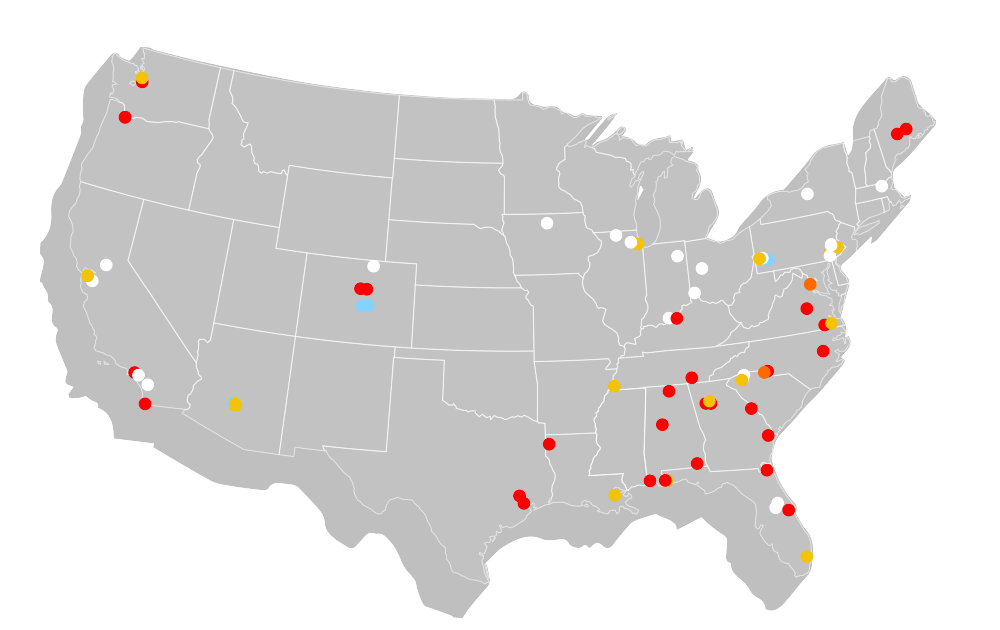Applied Technical Services’ ASTM G155 testing helps clients determine the effects of solar radiation on their products. While common knowledge states that a variety of weathering conditions (including heat, moisture, and salinity) can gradually undermine the performance of a product, sunlight often goes overlooked by the layperson.
The electromagnetic radiation produced by the sun includes more than just the visible light that, quite literally, brightens our day, but also higher frequencies of energy called Ultraviolet (UV) waves that can have negative effects on paints, coatings, adhesives, fabrics, textiles, inks, leathers, polymers, and other commonly used materials over time. These changes may present themselves as washed colors, lost glossiness, increased vulnerability to impact, reduced tensile strength, or diminished abrasion resistance.
Third-party testing facilities like ATS perform xenon arc testing to ASTM G155 so that clients may assess how well their materials stand up to the effects of sunlight for its predicted service life.
Xenon Arc Testing and Related Capabilities
Xenon arc testing involves the use of a UV chamber to simulate the higher-frequency radiation that wears away at materials, as well as other phenomena common to an outdoor service environment such as temperature and moisture. Using this instrument, our technicians can faithfully reproduce day/night cycles to best determine how these conditions will affect the sample.
ASTM G155 specifically allows us to administer the UV waves through a pane of glass to observe the effects that this radiation has on automotive interiors and other materials that, while used indoors, may still incur solar radiation. We maintain numerous, large QUV testing chambers to accommodate long exposure cycles.
Our equipment can fulfill all requirements set out in the G155 specification, as well as the following maximum capabilities:
- Multiple options for radiance ranges
- Narrow: 340nm–420nm
- Broad: 300nm–400nm
- Illuminance Control: 400nm–750nm
- Temperature range of 10°C–70°C
- Relative humidity range of 10%–75%
- Can achieve 100% relative humidity during night cycles
- 6500cm2 (1008in2) exposure space
- Can support either flat or three-dimensional samples
A Multi-Disciplinary Approach
Because UV weathering can cause a wide array of unwanted effects, ATS’ environmental testing division partners with our other in-house testing branches — providing supplementary analysis to quantify the change caused by cycles of radiation. These methods include:
Xenon Arc Standards
Beyond our proficiency in performing ASTM G155 testing, we also offer the following xenon arc testing capabilities:
- ASTM D7869
- ASTM D6695
- ASTM D4459
- ASTM D4355
- ASTM D2565
- ISO 4892-2
- VDA 75202
- SAE J2527
- SAE J2412
- SAE J1885
We maintain ISO/IEC 17025:2017 accreditation through the A2LA to perform testing to ASTM G155, as well as each of the standards mentioned above. This list does not reflect the full range of our xenon arc testing capabilities, and so we encourage clients who do not see their desired specifications to ask us whether we can fulfill their testing requirements.
About ATS
Since our founding in 1967, Applied Technical Services has steadily expanded our capabilities to better answer the varied needs of our clientele. What began as a trio of engineers working alongside local businesses from the confines of their shared office in our founder’s basement has since grown into a national presence in the fields of testing, calibration, inspection, forensic investigation, training, and (of course) consulting engineering. We perform all ASTM G155 testing in our Marietta lab under the scope of our ISO 9001:2015-registered quality management system to ensure accurate reporting and quick turnaround times.
A variety of quality management guidelines, industry standards, and government regulations call for xenon arc testing on materials expected to complete a service life exposed to the gradual effects of sunlight — why not get your analysis performed by the best? We take a closer look!



